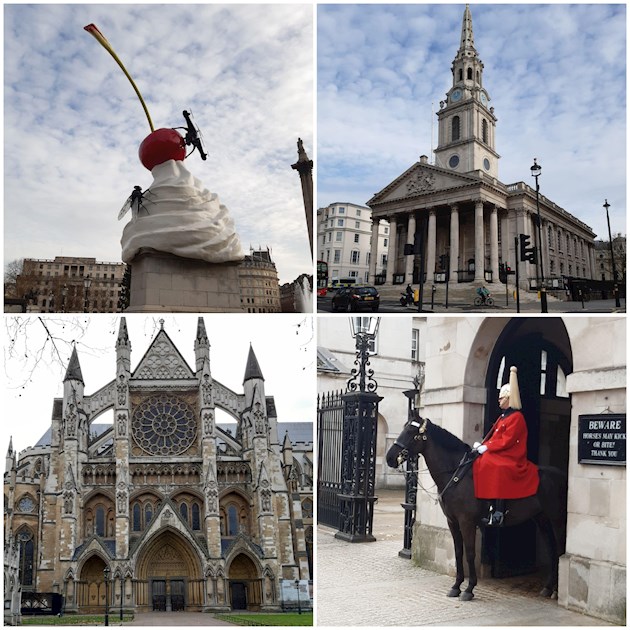Photo 1
The 4th plinth Trafalgar Square, is it art ?
I will let you decide 🙂
Heather Phillipson’s vast physical and digital sculpture tops the Fourth Plinth with a giant swirl of whipped cream, a cherry, a fly and a drone that transmits a live feed of Trafalgar Square. Entitled THE END it suggests both exuberance and unease, responding to Trafalgar Square as a site of celebration and protest, that is shared with other forms of life. The live feed of Trafalgar Square picked up by the drone’s camera is visible on a dedicated website theend.today
.
Photo 2
ST Martin's in the Field.
.
The earliest extant reference to the church is from 1222, with a dispute between the Abbot of Westminster and the Bishop of London as to who had control over it. The Archbishop of Canterbury decided in favour of Westminster, and the monks of Westminster Abbey began to use it.
Henry VIII rebuilt the church in 1542 to keep plague victims in the area from having to pass through his Palace of Whitehall. At this time, it was literally "in the fields", an isolated position between the cities of Westminster and London.
It became a principal parish church west of the old City in the early modern period as Westminster's population grew. When its old structure was found to be near failure, the present building was constructed in an influential neoclassical design by James Gibbs in 1722–1726. The church is one of the visual anchors adding to the open-urban space around Trafalgar Square.
.
Photo 3
Westminster_Abbey.
Westminster Abbey, formally titled the Collegiate Church of Saint Peter at Westminster, is a large, mainly Gothic abbey church in the City of Westminster, London, England, just to the west of the Palace of Westminster. It is one of the United Kingdom's most notable religious buildings and the traditional place of coronation and burial site for English and, later, British monarchs. The building itself was a Benedictine monastic church until the monastery was dissolved in 1539. Between 1540 and 1556, the abbey had the status of a cathedral. Since 1560, the building is no longer an abbey or a cathedral, having instead the status of a Church of England "Royal Peculiar"—a church responsible directly to the sovereign.
Since the coronation of William the Conqueror in 1066, all coronations of English and British monarchs have been in Westminster Abbey. There have been 16 royal weddings at the abbey since 1100. As the burial site of more than 3,300 persons, usually of prominence in British history (including at least sixteen monarchs, eight Prime Ministers, poets laureate, actors, scientists, military leaders, and the Unknown Warrior),.
The following English, Scottish and British monarchs and their consorts are buried in the Abbey:
Sæberht of Essex (possibly)Edward the Confessor and Edith of WessexHenry III of England (Eleanor of Provence buried at Amesbury)Edward I of England and Eleanor of CastileEdward III of England and Philippa of HainaultRichard II of England and Anne of BohemiaHenry V of England and Catherine of ValoisPossibly Edward V of England and his brother, Richard, Duke of York (The so-called Princes in the Tower; remains exhumed from the Tower of London and entombed in 1674)Anne Neville, wife of Edward of Westminster (1470-71; buried at Tewkesbury) & Richard III (1472-85; buried at Leicester Cathedral)Henry VII of England and Elizabeth of YorkEdward VI of EnglandAnne of Cleves, wife of King Henry VIII (buried at Windsor with Jane Seymour)Mary I of EnglandElizabeth I of England as shown on her tomb
Mary, Queen of Scots, mother of James VI & I (brought from Peterborough Cathedral in 1612)Elizabeth I of EnglandIn the 19th century researchers looking for the tomb of James I partially opened the underground vault containing the remains of Elizabeth I and Mary I of England. The lead coffins were stacked, with Elizabeth's resting on top of her half-sister's.James I of England and his wife, Anne of DenmarkThe position of the tomb of James I of England was lost for two and a half centuries. In the 19th century, following an excavation of many of the vaults beneath the floor, the lead coffin was found in the Henry VII vault.Charles II of England and ScotlandMary II of England and ScotlandWilliam III of England and II of ScotlandAnne, Queen of Great Britain and her husband, Prince George of DenmarkGeorge II of Great Britain and his wife, Caroline of Ansbach..
following are buried in the South Transept which is known as Poets' Corner:
Robert AdamRobert BrowningWilliam CamdenThomas CampbellGeoffrey ChaucerWilliam CongreveAbraham CowleyWilliam DavenantJohn DenhamCharles DickensMichael DraytonJohn DrydenAdam FoxDavid GarrickJohn GayGabriel GoodmanGeorge Frederick HandelThomas Hardy (heart buried in Stinsford)Sir Henry IrvingDr Samuel JohnsonRudyard KiplingThomas MacaulayJohn MasefieldJohn MiltonAnne OldfieldLaurence Olivier, Baron OlivierThomas ParrRichard Brinsley SheridanEdmund SpenserAlfred Tennyson, 1st Baron Tennyson..Photo 4The Household Cavalry are still on guard outside Horse Guards building in Whitehall, but no tourists around🙁Bit long sorry 😊
